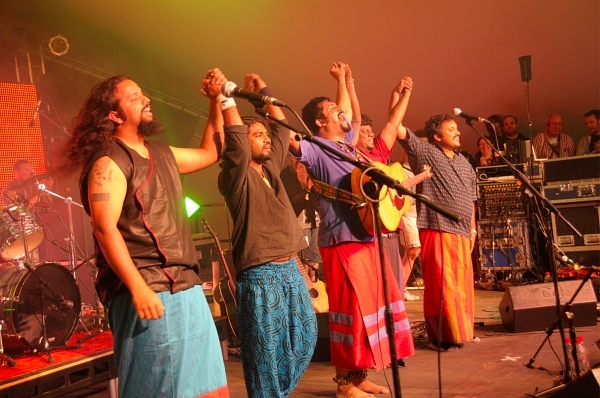Culture
Remixing the Sacred

The trend of fusing traditional devotional music with modern forms is encouraging
The power of music is universally acknowledged. Combined with spiritually-charged words, music can take the singer and the listener to another level. This is why music has been favoured by many as a form of communication, and even communion, with God.
Take for example, the Indian kirtan, which involves the rhythmic chanting of God’s name or the singing of God’s praises in accompaniment with instruments like the harmonium, drums, cymbals and other instruments. Usually done in chorus with a leading kirtankaar, this musical style is favoured especially by the Vaishnava communities among Hindus, Sikhs and even Buddhists.
The art of kirtan is now finding favour with Western audiences and how! This writer was reading about the rising popularity of kirtan festivals in a leading daily the other day, and the fusion fan in me was delighted.
I was reminded of some of the wonderful work contemporary artistes like Raghu Dixit are doing to preserve Indian folk music traditions. One also hears of a lot of Sufi fusion music these days, and I think it is a fantastic trend.
The old Indian devotional music form of kirtan, fused with soul, jazz, rap, hip-hop and electronica, is finding new fans in the West, especially the US. Practitioners of this art form are mixing and matching everything – from Vedic mantras to Yogic elements to Bhakti sangeet — and creating spiritually-uplifting music.
A typical kirtan concert will have a mixed crowd usually standing or sitting on the floor following the lead of the artist. It isn’t very different from a Hindu temple setting, except you have a guitar-wielding musician instead of a guru.
Kirtans have been a popular form of devotional music in India since the beginning of the Bhakti tradition. Saints like Chaitanya Mahaprabhu in Odisha and Bengal, Tukaram in Maharashtra, and Guru Nanak in Punjab popularised this devotional art form.
Unlike the formality and technical correctness required of Vedic mantra chanting, kirtans were flexible and accessible to all sections of the society. One didn’t have to be afraid of the consequences of incorrect pronunciation and simply partake in the joy of singing God’s praises.
What elevates the spirit in chanting or singing mantras is the inherent power of sound. The idea of sacred primeval sounds like “Om” have been rendered in the Vedas. The Goddess Saraswati in her Vedic form is known as Vāc Devi or the Goddess of Speech. Prajapati Brahma creates her and she in turn creates the Vedas.
The Vedas are, therefore, considered to be divine revelations of no human authorship. The primeval sound is also revered as Shabd Brahman and is the point of meditative focus for many spiritual seekers.
In Mantra Sadhana, sound is pure energy of vibrations. Used correctly, it can affect great positive changes in the practitioner. Sounds are believed to have divine power in India, which translates into traditions like the kirtan, which are practiced to this day with great religious fervour.
However, the art of kirtan need not be strictly religious. Modern practice, especially in the context of kirtan festivals and revivalist music, allows for much more flexibility and secularity. With a mixture of elements from all religions within a concert span of a few hours, ‘new age kirtan’ can appeal to people from all kinds of backgrounds.
Now, the idea of a ‘Hippy-trippy’ crowd swaying to Harinam Sankirtan is hardly sacred by traditional standards. However, isn’t the idea of the younger generation partaking in an Indian devotional practice, amazing?
Fusion seems to me to be the only way of preserving, packaging, presenting and making palatable old art forms. Fusion exposes the new generation to dying traditions and inspires new talent. Purists may deem it sacrilegious, but something is surely better than nothing.
The ‘Vedic purity’ of the mantras may not be retained in such musical experiments, but one cannot deny the benefits of congregational singing in this context. Kirtan as a two-way, interactive form of art, binds the community in a spiritual thread, albeit temporarily. Let’s raise our cymbals to that for now, shall we?
Support Swarajya's 50 Ground Reports Project & Sponsor A Story
Every general election Swarajya does a 50 ground reports project.
Aimed only at serious readers and those who appreciate the nuances of political undercurrents, the project provides a sense of India's electoral landscape. As you know, these reports are produced after considerable investment of travel, time and effort on the ground.
This time too we've kicked off the project in style and have covered over 30 constituencies already. If you're someone who appreciates such work and have enjoyed our coverage please consider sponsoring a ground report for just Rs 2999 to Rs 19,999 - it goes a long way in helping us produce more quality reportage.
You can also back this project by becoming a subscriber for as little as Rs 999 - so do click on this links and choose a plan that suits you and back us.
Click below to contribute.
Latest